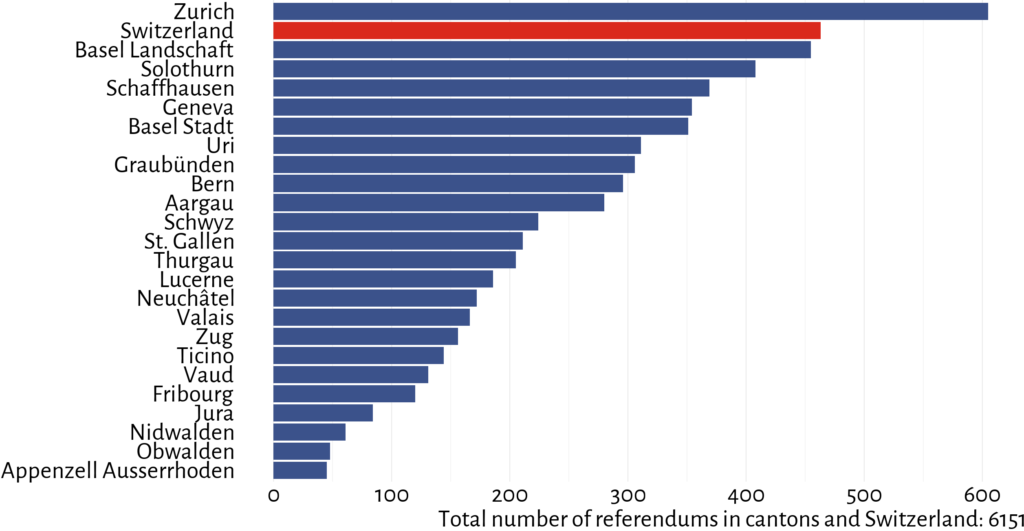
National and cantonal referendums in comparison
«The World of Referendums: 2024 Edition» examines Swiss referendums at national and cantonal level over time. The report is based on the Referendum Database (RDB) of the Centre for Democracy Studies Aarau (CDA), which records referendums worldwide and makes them comparable.
The cantons are growing weary of voting
Figure 1: The number of cantonal referendums is declining. It seems that the cantons are becoming weary of voting. However, the reasons for this development are still unclear.
- Mandatory referendums: Since the 1970s, the number of mandatory referendums in the cantons has been steadily declining. Mandatory referendums account for a large proportion of referendums at cantonal level (around 60% since 1970). As a result, the total number of cantonal referendums has also fallen.
- Optional referendums: The number of optional referendums has remained relatively constant since the 1970s, rising slightly since the 2000s. However, for several years now, there has been a downward trend towards the level seen in 1970.
- Counterproposals: Counterproposals to cantonal popular initiatives remained constant for a long time until they increased sharply in the 2010s, along with the number of popular initiatives. Today, the number of counterproposals is approaching the level of 1970 again.
- Popular initiatives: Compared to 1970, the number of cantonal popular initiatives was initially significantly higher in the 1980s and 1990s. After a brief decline in the 2000s, the number of cantonal referendums peaked in the 2010s. Since then, the number of popular initiatives has returned to a level similar to that seen in the 1980s and 1990s.

Fig. 1: Development of cantonal referendums over time, 1970–2024 (1970 = 100%), smoothed. (Source: RDB)
The cantons practise direct democracy in different ways
Same instruments, different applications: Although the cantons draw on the same toolbox of direct democratic instruments, there are significant differences between them in practice. Depending on where they live, Swiss citizens experience very different forms of direct democracy. This is reflected both in the number of votes per canton and in the type of votes.
Number of referendums
Figure 2: Zurich leads the way with around 600 votes since 1970, followed by national votes, Basel-Landschaft and Solothurn. With just under 300 votes, the canton of Aargau ranks in the upper midfield. At the bottom of the scale is Jura, the youngest Swiss canton, with around 80 votes, followed by Fribourg and Vaud with around 120 votes each. The former Landsgemeinde cantons of Nidwalden, Obwalden and Appenzell Ausserrhoden have held the fewest votes. The two Landsgemeinde cantons of Appenzell Innerrhoden and Glarus are not included in the chart.

Fig. 2: Number of national and cantonal referendums (excluding Landsgemeinde votes), 1970–2024. (Source: RDB)
Type of referendum
At the same time, the cantons differ greatly in terms of the types of voting used:
- At the national level, around two-thirds of all votes are triggered by signature collections. One-third of these are popular initiatives and optional referendums. The remaining third are mandatory referendums or counter-proposals.
- At the cantonal level, only around one third of referendums are triggered by signature collections. The remaining two thirds of cantonal referendums are 1 Landsgemeinde votes are only partially recorded in the RDB. This is why the cantons of Appenzell Innerrhoden and Glarus are completely missing, as they primarily use Landsgemeinden for direct democratic decision-making. Referendums have been recorded for Nidwalden since 1997, for Appenzell Ausserrhoden since 1998 and for Obwalden since 1999. mandatory referendums, counter-proposals and executive/legislative referendums, which do not require a signature collection.
- Figure 3: There are significant differences between the cantons in terms of the type of vote. These can be illustrated by the proportion of popular initiatives in the total number of referendums in a canton. The cantons of Vaud (40%) and Nidwalden (34%) have the highest proportion of popular initiatives. With 17%, the canton of Aargau is in the middle of the pack. In contrast, Valais and Graubünden have the lowest proportion, with 5% each.

Fig. 3: Proportion of referendum types in selected cantons, 1970/1997–2024. (Source: RDB)
Explanatory approaches
- Changes over time: The decline in mandatory referendums at the cantonal level could be attributed to changes in cantonal constitutions. However, this would need to be investigated in greater depth, as would the changes in the number of other types of votes at the cantonal level.
- Differences between the federal government and the cantons: In general, there are fewer votes in most cantons than at the federal level. The authors believe this is because most cantons have stricter requirements than the federal government regarding the ratio of signatures to the number of eligible voters. This makes it more difficult to launch popular initiatives and optional referendums. The population also tends to be less interested in cantonal proposals, which in turn makes it more difficult to collect signatures.
- Differences between cantons: The cantons use direct democratic instruments in different ways. The authors think this is because of how each canton’s constitution is set up. For example, direct democratic tools are more diverse in German-speaking Switzerland than in French-speaking Switzerland or Ticino. Also, the number of signatures needed to get something on the ballot tends to be lower in German-speaking Switzerland than in French-speaking Switzerland or Ticino.
- Direct democracy toolbox: As a constitutional requirement of the federal government, all cantons must provide for mandatory constitutional referendums and popular initiatives on partial or total revisions of their constitutions. Beyond that, the cantons are free to use the direct democracy toolbox as they see fit:
- All cantons have mandatory and/or optional financial referendums, which do not exist at federal level. Financial referendums require expenditure above a certain amount and/or duration to be approved by the people.
- Around half of the cantons have a mandatory legislative referendum in addition to the mandatory constitutional referendum. This means that, in addition to constitutional amendments, certain legislative amendments are also subject to a mandatory vote.
- In some cantons, generally binding parliamentary decisions and parliamentary ordinances are also subject to optional referendums.
- In some cantons, the parliament can also launch a referendum.
Further resources
Report
Ezzaini, Juri, Jonas Wüthrich, Salim Brüggemann, Kymani Koelewijn, Gianluca Sorrentino, Robin Gut, and Uwe Serdült. ‘The World of Referendums: 2024 Edition.’ Study reports from the Centre for Democracy Aarau, 30. Aarau: Centre for Democracy Studies Aarau (ZDA), 2024. The report and data set are available at https://report.rdb.vote/ and https://c2d.ch/ respectively.
The Referendum Database RDB
The report «The World of Referendums: 2024 Edition» is based on data from the Referendum Database (RDB). The database was founded in 1994 at the University of Geneva. It contains key figures on all national referendums worldwide, as well as a growing number of subnational referendums. The additional institutional variables for each country and interactive graphics make the RDB a valuable tool for researchers and interested citizens. An interdisciplinary team of lawyers and political scientists at the Centre for Democracy Studies Aarau manages the RDB and continuously develops it further. Additional reports are published periodically.
About the Centre for Democracy Studies Aarau (CDA)
The Centre for Democracy Studies Aarau is a scientific research centre supported by the University of Zurich, the University of Applied Sciences and Arts Northwestern Switzerland, the Canton of Aargau and the City of Aarau. It conducts basic research and addresses current issues relating to democracy – regionally, nationally and globally: www.zdaarau.ch
Contact
Robin Gut
Project manager «The World of Referendums: 2024 Edition»
076 470 87 05
robin.gut@zda.uzh.ch